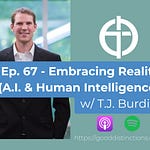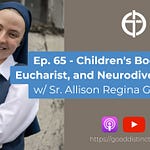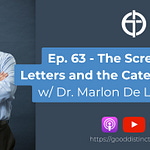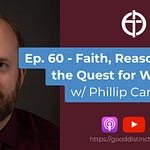NOTE: THIS EPISODE WAS PUBLISHED BEFORE OUR REBOOT. willwrightcatholic.com is now gooddistinctions.com
What is the Sacred Triduum?
The most important Liturgical Season of the Church year is the Sacred Triduum: three days to change the world! Lent is over and, from the evening of Holy Thursday to the evening of Holy Saturday, we celebrate one long day, the unity of the Paschal Mystery of Jesus. On these three days, we celebrate the Last Supper, Passion, Death, and Resurrection of our Lord Jesus Christ.
Holy Thursday and the Mass of the Lord’s Supper
Thursday night begins the sacred Easter Triduum in which the whole Church devotes herself to the remembrance of the night of the Last Supper. The Ceremonial of Bishops, no. 297, says this:
“At the supper on the night he was betrayed, the Lord Jesus, loving those who were his own in the world even to the end, offered his Body and Blood to the Father under the appearance of bread and wine, gave them to the apostles to eat and drink, then enjoined the apostles and their successors in the priesthood to offer them in turn. This Mass is, first of all, the memorial of the institution of the eucharist, that is, of the Memorial of the Lord's Passover, by which under sacramental signs he perpetuated among us the sacrifice of the New Law. The Mass of the Lord's Supper is also the memorial of the institution of the priesthood, by which Christ's mission and sacrifice are perpetuated in the world. In addition, this Mass is the memorial of that love by which the Lord loved us even to death.”
On this day, priests do not celebrate Mass alone, nor are Masses offered for special small groups. The altar is decorated with moderate flowers and there are a few oddities. For example, after the Gloria is sung (now back because Lent is over), the Church bells remain silent until the Easter Vigil.
Also during this special Mass, there is the Washing of the Feet, which mirrors the washing of the Apostles’ feet by Jesus. The priest removes his chasuble and washes the feet of a few people to call to mind this sacred action on the night of the Last Supper. Remember, the Last Supper, and this action, is part of how Jesus instituted the Sacrament of Holy Orders!
At the end of the Mass of the Lord’s Supper, to show that the Triduum is a unified whole, the Mass does not end. Instead, the Blessed Sacrament is processed to a suitable place for exposition and adoration. Normally, this time of adoration continues until midnight in the Parish. Unlike a normal time of adoration, a monstrance is not used. Instead, a large ciborium containing all of the consecrated Eucharist to be used the next day is adored.
It is customary during this time to sing the beautiful Pange Lingua Eucharistic chant written by St. Thomas Aquinas.
Good Friday of the Lord’s Passion
Next up is Good Friday. Good Friday is the second day of the Sacred Triduum, in between Holy Thursday and Easter Vigil. Good Friday is the commemoration of the passion and death of Jesus Christ on the cross at Calvary. It is always three days before Easter, which marks the Resurrection of Jesus from the dead!
It might be confusing why we call this horrible day “good.” This term comes from an obsolete use of the term in English which means “pious” or “holy.” For hundreds of years in the Latin Church it was called Feria sexta in Parasceve which means “Friday of Preparation” and then after the 1955 Holy Week reform it was renamed Feria sexta in Passione et Morte Domini which means “Friday of the Passion and Death of the Lord.” In the current Latin edition of the Missal, it is Feria sexta in Passione Domini or “Friday of the Passion of the Lord.”
One of the strangest things about Good Friday is that Mass is not offered anywhere in the world. Tabernacles are empty, with the doors wide open. The altar is stripped of cloths and candles. And the holy water receptacles are empty. It is surreal, empty, and solemn. Jesus Christ, God made man, has died on the Cross, and He has been laid in the tomb. (Of course, we know the rest of the story: death could not hold Him down and He rose from the dead three days later!!)
Penance
There is a distinction in the teachings of the Church between forgiveness and consequences for sins. God forgives us when we ask for forgiveness with true sorrow for our sins, but there are still eternal consequences to our actions. Our relationship with God can still need healing in terms of conformity to Him and communion with Him. Even after we confess our sins, we can still have attachments to certain sins, for example.
The Lord helps us to grow in cooperation with His grace through the gift and opportunity of doing penance. Followers of Christ are called to do formal penance, such as fasting, and informal penance such as intentionally going out of the way to be kind to someone. In doing penance, whether formal or informal, we are uniting ourselves to the superabundant merits won by Christ on the Cross.
For penance to have its full effect in ourselves and to help us grow in holiness, this intentionality is necessary. When we act with Christ, we are drawing nearer to Him just as He is already near to us. Doing penance is our answer to the justice of God. We know that we are sinners in need of grace, and we unite our thoughts, prayers, and actions to communion with Him.
Penance can be done formally or informally, but there are certain times when the whole Church is called to collective penance. Canon Law teaches that “the penitential days and times in the universal Church are every Friday of the whole year and the season of Lent (Canon 1250).” This is why we say that every Friday is a mini Good Friday!
Fasting and Abstinence
In the early life of the Church, there was a fast before every major feast or important event. Historically, fasting comes from the Latin statio which means to stand watch or on guard. Another type of fast is called abstinence which pertains to abstaining from meat or fats. In the second case, this is an act of self-control. For the first meaning of fasting, the idea is in waiting, watching, and anticipating something.
There is a fast in place for the Holy Eucharist. The faithful fast from everything except water and medicine at least one hour prior to receiving Holy Communion. In the past, this fast extended to midnight on the previous day. This is where we get the term breakfast because, after receiving Holy Communion, we are breaking the fast.
Today, there are two days of required fasting: Ash Wednesday and Good Friday. On these two days, in the Latin Rite, we may eat one small meal and two other small meals that when combined are not equal to a normal size meal. This is obligatory for those who are 18 years old up to 59 ½ years old. For those younger than 18 and older than 60, the fast is optional and based on medical fitness to do so.
Abstinence from meat is required on Ash Wednesday and all Fridays for those above the age of 14 years old. Yes, you read that correctly. Canon Law says, “Abstinence from meat, or from some other food as determined by the Episcopal Conference, is to be observed on all Fridays, unless a solemnity should fall on a Friday (Can. 1251).”
The United States Conference of Catholic Bishops (USCCB) teach the following:
“Christ died for our salvation on Friday. Gratefully remembering this, Catholic peoples from time immemorial have set apart Friday for special penitential observance by which they gladly suffer with Christ that they may one day be glorified with Him. This is the heart of the tradition of abstinence from meat on Friday where that tradition has been observed in the holy Catholic Church.”
Put simply: Christ gave up His Flesh for the life of the world on Friday and so we give up flesh for Him on Friday.
The USCCB recommends that the faithful continue meatless Fridays throughout the year, but it is no longer “binding under pain of sin.” Outside of Lent, the faithful may eat meat, but they must do some other penance in its stead.
Holy Saturday and the Mother of All Vigils
Finally, we have Holy Saturday and the Easter Vigil. The Easter Vigil is the greatest liturgy of the entire year in the Roman Rite of the Catholic Church. The Roman Missal guides the celebration of this great night and even refers to the Easter Vigil as the “mother of all vigils” which is quoting St. Augustine from the 5th Century. So, the Easter Vigil has real history.
Throughout the years, this celebration did get lost for a time, lacking the full vigor it once had. However, Pope Pius XII in the 1950s restored the prominent celebration of the mother of all vigils on the Saturday evening before Easter Sunday.
The Easter Vigil is packed with breathtaking symbolism and meaning. And it is packed with a celebration of everything that we hold dear as Catholics. Christ is seen throughout in amazing grandeur.
Fire
First, it must be mentioned, the Easter Vigil begins with a bonfire outside. This holy fire is called the Lucernarium and the liturgy begins with the celebrant blessing the Easter fire. This fire is symbolic of Christ who is not dead, but very much alive, burning brightly. From this fire, coals are taken out to light the incense and the fire is also used to light the new Paschal candle.
Throughout the entire liturgical year, the Paschal candle stands in or near the sanctuary of the church or near the baptistry as a sign of Christ. This candle is triumphantly marched into the church which is completely dark at this point. The single burning flame enters the back of the church carried by a priest or deacon who then raises it above his head and sings, “Lumen Christi,” (the Light of Christ) to which the people respond, “Deo Gratias” (Thanks be to God). This is repeated for a total of three times as the priest nears the sanctuary of the church.
While the Paschal candle makes its way to the altar area, little candles held by the congregation are lit from the Paschal candle and the light of Christ truly begins to spread throughout the church which is now lit by candlelight.
Beautiful Music
Once the candle makes it to the front, the Easter Proclamation or Exsultet is proclaimed by the priest, deacon, or cantor. This triumphant and beautiful chant is the prelude to the celebration of Easter. It speaks of night and light, of the place and time of the moment, of the priest and congregation, and it anticipates the glorious Resurrection of Jesus Christ.
After the long subdued nature of the Lenten Season, the Easter Vigil breaks in with glory and anticipation. During the Gloria in Excelsis for example every bell available is rung all throughout the chanting or singing of the hymn. Each of the readings during the Liturgy of the Word have an accompanying responsorial psalm. There are many other musical additions to the liturgy called for in the Roman Missal, including the Litany of the Saints before the Blessing of the Baptismal Water. The music at the mother of all vigils is something truly magnificent.
Abundant Proclamation of the Word of God
The Liturgy of the Word is kicked into high gear. There are seven possible readings (minimum of three), each with a selected responsorial psalm sung in between the readings and prayers by the priest following each psalm.
Then the Gloria in Excelsis is sung. The Collect is said. A reading from St. Paul’s Epistle to the Romans is proclaimed. The Alleluia is proclaimed for the first time since before Lent. Yet another Psalm is sung. Then the Gospel is read and the Homily is given.
Blessing of Baptismal Water and Celebration of the Sacraments of Initiation
The remainder of the liturgy is a remarkable tour de force of the Sacraments of Initiation of the Church. The Baptismal water is blessed, those entering the Church make a profession of faith, renounce sin, and are baptized. Many of these adults have been preparing for this moment for a year or more.
Next, those who are not Catholic but who are previously baptized make a profession of faith in the Catholic Church are received into full communion with the Church. Then, the new Catholics, now all baptized and officially members of the Catholic Church, are invited to the celebration of the Sacrament of Confirmation.
The entire congregation is then invited to renew their own baptismal promises and receive a blessing from the priest with the newly blessed baptismal water. The Liturgy of the Eucharist then takes place in the normal way.
However, now baptized and confirmed, the new Catholics (neophytes) receive the Body, Blood, Soul, and Divinity of Jesus Christ in the Holy Eucharist for the very first time. What a splendid moment to behold. This is the pinnacle of our Faith. With so many people leaving the practice of the Faith, this holy night is one in which to take part. By being present and praying for these new Catholics, we show our support to these new members of the Body of Christ.
Conclusion
The Sacred Triduum is the capstone of Holy Week and the summit of the Church’s liturgical life. What a beautiful time to enter into each day and remember in gratitude what Jesus Christ did in His Passion, Death, and Resurrection. And more than a mere remembering, through the Liturgy, we are taking part in these moments. Because the memory of God is perfect and brings the present and past collapsing into one another in a beautiful mystery. Have a very blessed Triduum and Easter, everyone.












